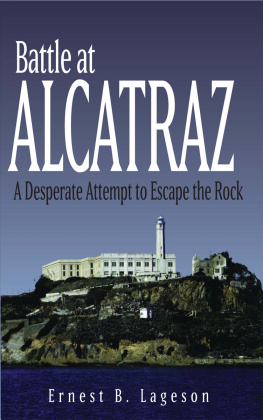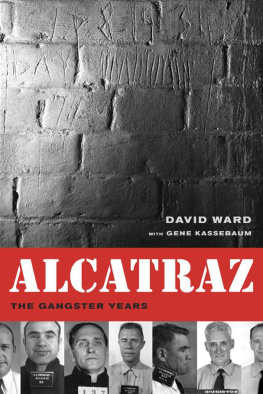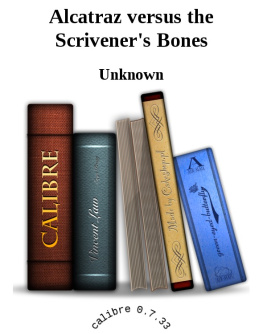The world breaks everyone, and afterward, some are strong at the broken places...
-Ernest Hemingway
Letters from Alcatraz
Michael Esslinger
Foreword by
Larry Quilligan
Former Alcatraz Correctional Officer
Ocean View Publishing Company
San Francisco, California
Letters from Alcatraz
By Michael Esslinger
Copyright 2009, Revised 2013
All Rights Reserved. No part of this book may be used or reproduced in any form or by any electronic or mechanical means including informational storage or retrieval systems without written permission except in the case of brief quotations embodied in critical articles and reviews.
For information contact Ocean View Publishing, P.O. Box 580, Marina CA 93933

E-Mail: coastbooks@aol.com
ISBN: 0-9704614-2-9
ISBN13: 978-0-9704614-2-1
Library of Congress Catalog Card Number: 2008934941
The principle letters in this collection are held as United States Public Records in the National Archives and Records Administration, United States Library of Congress, and the Bureau of Prisons, Washington D.C. Several letters were also reprinted by permission from the Bob Baker estate, the Alcatraz Alumni Association, Michael Esslinger, and Robert Victor Luke.
Several narrative excerpts contained in Alcatraz - A Brief History and select inmate biographies originally appeared in Alcatraz A Definitive History of the Penitentiary Years , by Michael Esslinger. Some chapter narratives for Mickey Cohen and James Whitey Bulger contain brief excerpts of material created under the Creative Commons License with various author contributions. The original interview material from Bulger and Esslinger are protected under copyright. Formatting of passages and paragraphing changes specific to the Bulger interviews have been made to improve readability.
All original source information is included in Alcatraz A Definitive History of the Penitentiary Years.
No biographies or narratives within this book have been authorized, endorsed, implied or otherwise by those persons named or associated.
Original Book Design and Composition by John Reinhardt
Original Book Cover Design by Jim Zach
Editor: Ana Brazil
eBook Design: eBook Architects
For Julie
Alcatraz Rules and Regulations for Correspondence
PRIVILEGES: You are entitled to food, clothing, shelter and medical attention. Anything else that you get is a privilege. You earn your privileges by conducting yourself properly. Good Standing is a term applied to inmates who have a good conduct record and a good work record and who are not undergoing disciplinary restrictions.
CORRESPONDENCE: Upon entrance to the institution, each inmate will be given a form to fill out, listing the persons with whom he wishes permission to correspond. After approval of the list, inmates may correspond only with the approved correspondents. You will refrain from discussing other inmates or institutional affairs. Violent or abusive letters will not be mailed. Correspondence is limited to two (2) outgoing and seven (7) incoming letters a week. All regular inmate mail will be collected by the evening watch Officer in the cellhouse. Writing materials are issued during the Tuesday P.M. bath line, at the supply table in the clothing room.
SEALED CORRESPONDENCE: As stated in Section 27, sealed correspondence may be addressed to certain Officials. Such letters may be sealed and placed in the special mail box which is located at the West End of the Cellhouse. You are not required to place any identifying information on the envelope and it will be forwarded to the Bureau without inspection.
SPECIAL HOLIDAY MAIL: In addition to your regular mail privileges you will be allowed to send your Mother an extra letter on Mothers Day. At Christmas time you will be allowed to mail (4) Christmas Cards. You may receive greeting cards only on the following occasions: Christmas, Easter, Fathers Day and your birthday. Inmates will not ask Officers, Officials or civilians to write or post letters for them or receive mail through Officers, Civilians or Officials except when acting in their official capacity.
Contents
Foreword
Larry L. Quilligan, Correctional Officer,
USP Alcatraz, 19491951

A sentence to Alcatraz translated into a life set in slow motion. The life of an inmate on the Rock was shaped by a firm and consistent regimen, which droned on day in, day out, year after year, and decade after decade. Almost completely isolated from current events and the world outside, news seeped into the prison through letters from family members, magazines (with banned topics and articles removed), family visits, or an occasional classic movie. On occasion, a new inmate would bring in news or stories from another prison or the outside, and this news quickly became a central discussion topic for inmates living inside the Alcatraz curtain. All of these served as an inmates only link to the fast-paced society that was in constant view just across the San Francisco Bay.
My interest in Alcatraz stretches far into my youth. In February 1940 I made my first contact with the Alcatraz institution. While preparing an assigned high school civics class report, I wrote a letter to its first warden, James A. Johnston, requesting material for use in my presentation. Amazingly, I received a timely letter back from Johnston, but his response brief and non revealing:
February 6, 1940 Dear Sir: Responsive to yours of February 1, 1940, I am obliged to say that I do not happen to have any printed material regarding the activities of the Island. Not knowing what your particular interest may be, I cannot undertake to write a description of the place or an account of the activities in a brief letter. Sincerely, J.A. Johnston
Life inside Alcatraz, as I knew it in later years as a guard, was not glamorous or even remotely entertaining for those serving out their time. During my term, I came face-to-face with many of the more infamous inmates, including Robert Stroud the Birdman of Alcatraz, Alvin Creepy Karpis, and George Machine Gun Kelly. On Alcatraz, without exception, every man was treated equally. Young or old, infamous, famous or unknown, murderer or counterfeiter, an inmates conduct was the only compass for the few earned privileges allowed, or alternatively, taken away. Celebrity status or notoriety in the free world had no merit on the Rock.
The officers spent their work hours under the same roof as the inmates, and, in principal, endured the same regimen of the men they supervised. Even for officers, Alcatraz proved it could be a very dangerous place, especially when living and working along men who became desperate to escape. While officers governed the frequent counts and structured movements of the inmates, they also enforced a set of rules and regulations that endured only minor changes over the course of nearly three decades of Alcatrazs history.
The letters in this collection begin to chip away at the myths surrounding the Rock. They represent life inside and out of Alcatraz, in the words of many of Americas most well known incorrigibles. Most of these letters only represent the inmates viewpoint, but they still shed light on the issues that dominated the thoughts and opinions of those who served time both on and off Alcatraz.
For me, its been well over fifty years since I patrolled the cellblocks and gun towers of Alcatraz. The sounds and imagery are still crisp in my mind as I think back to those experiences. I remain intrigued about the history and inner workings of Alcatraz, even with my direct link to its past.
Next page










